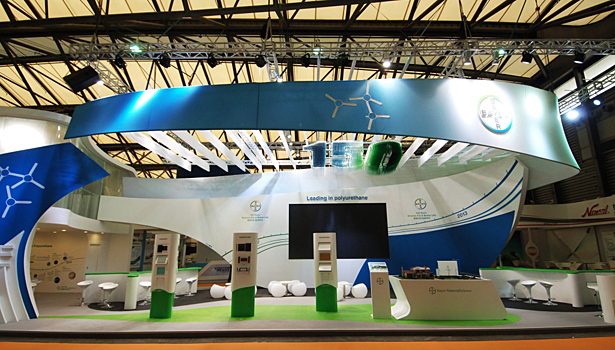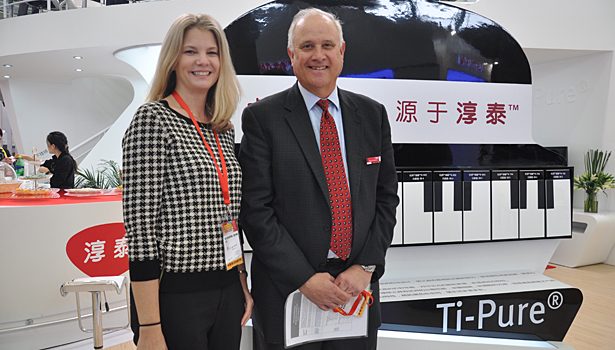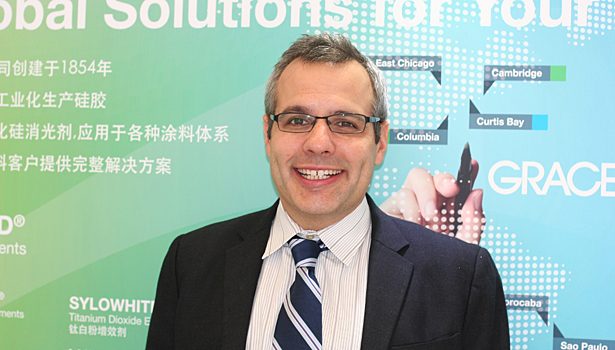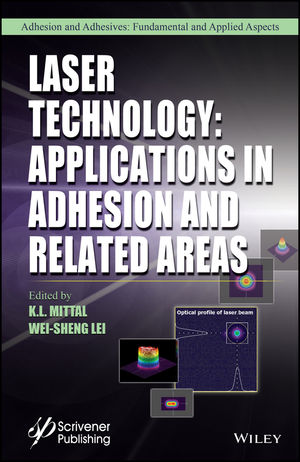The annual ChinaCoat show was held November 20-22 in Shanghai. The PCI staff was able to meet with several suppliers to the coatings industry. It is clear that companies understand the importance of having a presence in China, and many of them are investing heavily in the region. We discussed the Chinese market, as well as the technologies that were being featured at the show. Below is just a sampling of what we discovered.
Arkema
Wilson Foo, Asia Pacific President for Arkema Coating Resins, discussed Arkema’s investments in China. “Our goal at ChinaCoat is to continue to make customers, prospects and coatings industry leaders aware of the significant investments Arkema is making in our product and technology platforms,” he said. “Over the past 12 months since the last exhibition we have significantly grown our product offer, and have successfully started up a new emulsions production facility to better serve our customers in the Asia Pacific region,” Foo added.
The new plant produces a range of emulsion polymers used as binders for architectural coatings, building and construction products, adhesives and specialty coatings. The products include Encor® acrylic and styrene acrylic latexes, SNAP® nano-acrylic polymers, Celocor® opaque polymers, and Encor® Flex elastomeric latexes. The new facility features state-of-the-art automation and is adjacent to the company’s new research and development center, opened in October 2013.
In addition to the waterborne products produced in the new plant, the company markets a comprehensive line of coatings raw materials, including solventborne resins, powder coating resins and additives.
“The facilities we have put in place in Changshu represent one step in our plans to expand, both in the Asia Pacific region and globally, to ensure we meet our customers’ needs wherever they operate,” Foo concluded.
Axalta
Just one week before ChinaCoat, Axalta Coating Systems held an open day at its Shanghai Training Center, also home to its Asia-Pacific innovation center and global color center. This event celebrated the launch of the Cromax®family of automotive refinish products (Cromax is the new name of DuPont Refinish). At the event, guests witnessed the increased productivity and benefits of the Cromax Pro waterborne coating product,which helps to reduce the overall environmental footprint of the auto industry in China.
Axalta’s Cromax Pro waterborne coatings are part of a complete system that makes application easier and faster with a wet-on-wet process. This approach helps to achieve full coverage without having to flash between coats, ultimately improving the customer’s bottom line. Cromax Pro yields a dynamic finish derived from its color match and high coverage properties, enabling body shops to transform the repainted surface of a damaged car into looking new with half the coats normally required.
In addition to Cromax Prowaterborne coating products, in China the Cromax family of brands includes Centari®, which also promises improved productivity engineered for easy, quick and accurate application. Timothy Dawe, Managing Director of Axalta Greater China, explained,“In China, our Cromax brand coatings are being used by the leading car manufacturers who look to us as a constant source of innovation for their latest models. In the refinish sector, Axalta continues this commitment with Cromax®products that help our body shop and collision repair customers achieve their productivity goals from the front of the body shop to the back.”
China’s automotive industry, already the largest in the world, is on pace to double from 15.8 million units sold in 2012 to 27.7 million units sold in 2019. “With all other markets in its rearview mirror, automobile manufacturers in China are constantly seeking new innovations to enhance their operations and win market share in a competitive marketplace,” addedDawe.
Bayer MaterialScience
Bayer MaterialScience’s Coatings, Adhesives and Specialties (CAS) Business Unit highlighted its latest innovative polyurethane coating solutions in mobility, construction and consumer sectors, under the motto “Leading in Polyurethanes”. Visitors at the Bayer stand could touch and experience the featured exhibits through modern virtual and reality display technology.
According to Samir Hifri, Senior Vice President, CAS business unit, Bayer MaterialScience, Asia Pacific, “We at Bayer have full confidence in the future development of the Chinese market in general and the coating industry in particular. The fundamental drivers for a sustainable growth are ever more present and require strong industry partnership together with our customers, end users, government and academia.”
Asia is one of the strongest growth markets for Bayer MaterialScience and accounted for EUR 3.15 billion of sales in 2012. More importantly, Greater China is now Bayer's third largest single market globally. “In response to the dynamic market environment experienced in Asia Pacific and in China in particular, Bayer MaterialScience will further strengthen its commitment to growth and innovation in this region with clear focus on our core segments through market-driven innovation that address modern China’s megatrends, such as urbanization, climate change and emerging of middle class. Furthermore, we will open adjacent markets where polyurethane technologies can bring revolutions,” said Hifri.
“Our Asia R&D network is further strengthened by the newly inaugurated regional innovation hub in Shanghai. We are investing heavily in our people to improve the local innovation capabilities for unmet market needs,” said Anand Khot, Head of Application Development, CAS business unit, Asia Pacific.
Latest Innovative PU Coating Developments
The new generation of waterborne PU basecoat, formulated with Bayhydrol® polyurethane dispersions, makes it possible to meet the most demanding environment regulations without sacrificing the high performance of traditional solventborne coating systems. It has the typical advantage of PU coating, a good combination of hardness and toughness, which directly translates to better stone chip resistance and longer durability.
The China furniture industry is entering an important phase. How will it meet the new environment regulations and increase the added value of final products? Waterborne UV-curing PU coating, formulated with Bayhydrol UV is ideal for furniture manufacturers. Bayhydrol UV grades are suitable for a wide range of substrates, ranging from wood to plastic and film applications, to achieve different coating effects, which creates flexibility for the furniture designers.
For the IT and electronics industry, ‘thinner’ and ‘lighter’ are key words for trendy product design. Recently, composites such as carbon/glass fiber-reinforced plastic are favored. The surface of composites is quite coarse and has poor adhesion to coatings. Bayer MaterialScience has developed a cost-effective decorative PU coating solution, available in both solventborne and waterborne systems, to address this new market need. It helps the IT and electronics manufactures to enable lightweight products with attractive appearances and high performance surfaces.
Celanese
Under its new brand, Celanese -The chemistry inside innovation, Celanese Corporation highlighted a wide variety of products including vinyl acetate ethylene emulsions, acrylic emulsions, EVA polymers, vinyl acetate monomer (VAM) and solvents for use in coatings and adhesives applications.
According to Mark Oberle, Celanese Vice President of Sales, Asia, “Celanese is committed to growth in China and the Asia region, and supports our efforts through our largest chemical manufacturing complex located in Nanjing, China, and our commercial and technology center located in Shanghai.”
Celanese also showcased its EcoVAE® line of vinyl acetate ethylene (VAE) emulsions for use in ultra-low-odor, low-VOC decorative paints. “Celanese has a long history of assisting paint formulators with the difficult task of lowering VOCs while also reducing the unpleasant odor of interior paints, making a consumer-friendly product. Formulators appreciate that VAE emulsions are the best way to achieve their sales and marketing goals while reaching a high level of technical performance,” said Anna An, Commercial Director for Celanese emulsions, Asia.
The company also highlighted its Polysolvan® O solvent for use in automotive paints. Because of its very low volatility, Polysolvan O is used chiefly as a paint additive in the form of a highly effective flow agent.
Celanese offers a range of emulsions for use in industrial adhesives for paper packaging and converting, as well as for use in woodworking. Celvolit® VAE emulsions are widely used in the paper packaging adhesive space due to their low odor and low residual monomer levels, making them the emulsion of choice for food packaging, tobacco production and cartons. They also offer ease of formulation and good machinability.
Celanese also offers Ateva® EVA polymers for hot melt adhesives that offer a wide range of melt index and vinyl acetate content.
CPS Color – now Chromflo Technologies and COROB
On December 3rd, 2013, Chromaflo Technologies and CPS Color Colorants combined to create one of the leading independent global colorant system and pigment dispersion platforms. The former CPS Color Equipment Business Unit became a standalone company under name of COROB.
At Chinacoat 2013, still under the roof of CPS Color, COROB presented its efficient Tinting During Filling (TDF) system, a fully automated in-plant production line. The TDF concept includes in-can paint production, which produces base paint and colorants directly into the final packaging. Thus it does not only guarantee cleaner and safer operation, it also reduces production times, labor costs and material waste, the possibility to create the exact amount needed just in time, instead of tinting a large batch. Scalable technology and flexible configuration create a suitable solution for individual production needs. TDF offers a number of different automatic dispenser options and combinations that are compatible with different can sizes and shapes. Neither flow rate nor number of circuits are limited.
COROB also featured the fully automatic turntable dispenser FIRST 1. It is suitable for use with water-based or universal colorants and eases the transition from manual to automated tinting. Thanks to its precise and repeatable on-demand tinting it increases accuracy and customer satisfaction in every tinting process.
Chromaflo Technologies, the former CPS Color colorants business, presented its colorants in final application on the walls of a colorant house. Among others, it showcased Novapint™ D and Novapint™ E colorant ranges. These water-repellent and weather-proof colorants reliably tint exterior paint and protect facades and plasters. Visitors also witnessed the effect of the Novapint D solar reflective colorants. These colorants have been specially developed to offer a wide choice of colors for water-based facade paints and plasters and minimize heat build-up in architectural and decorative paint applications.
In China, COROB focuses more on in-plant machines rather than point-of-sale products. In addition to China, COROB sees much growth in Indonesia as well.
DataColor
According to William Lam, Director, Sales & Support, Asia Pacific at DataColor, the company continues to focus on color management and color matching solutions for industry. Coatings, both industrial and architectural, are a big focus for the company in China, as it can see the market potential. As the region continues to grow, Lam noted the importance of customer support, which DataColor is really focusing on right now. The company now has over 30 people in China to support customers in the region, including application training.
DataColor featured Datacolor Match® Pigment 2.2, an upgraded version of its intelligent color formulation solution, Match Pigment. Match Pigment 2.2 includes SmartMatch, a new technology that improves prediction accuracy for color formulas, introduces a patented method for accurate color matching of pigmented wood stains, offers flexible color correction options and improved data management. The software learns with each use and adapts future formula predictions to deliver more accurate first-time matches.
The company also featured its Datacolor 45G® Spectrophotometer. Measurements made with the 45G capture the effect of base color, gloss and texture on overall visual appearance. Automotive interior components, with varying texture and finish, each manufactured by different vendors, need to visually match. Datacolor 45G enables quality control of multiple components to a close numerical tolerance in order to achieve an overall match in color appearance. Coating applications can benefit from the 45G’s ability to detect changes in appearance from both gloss and base color.
Dow Coating Materials
Dow Coating Materials (DCM) has a strong presence in China, and the company has much confidence in coatings there. Of DCM’s 37 global manufacturing sites, 14 are in Asia. DCM also has 700 R&D employees in Shanghai.
“China and Southeast Asia are the largest sub-markets as well as the strongest driving force of the decorative coatings market in Asia Pacific. Market competition in China is fierce. Users and consumers continue to care about the quality and performance of the coatings while raising expectations for other attributes including stain resistance, low VOC, low odor and energy efficiency. This has created tremendous room for the coatings industry to improve the environment through innovations,” said Yoke Loon Lim, General Manager ofDow Coating MaterialsAsia Pacific.
Mr. Luo Kai, Business Director of Dow Coating Materials Greater China, stated, “China has a great economic outlook, and users and consumers have higher expectations for coatings. This has created tremendous room for the coatings industry to improve the environment through innovations. We understand that innovations will not always be smooth sailing, but we are willing to work with our customers to take on every technical challenge.”
In recent years, DCM has introduced raw materials solutions for highly decorative exterior wall coatings such as textured stone coatings, textured stucco coatings, elastic coatings and waterborne multicolored coatings. The waterborne MUTILCOLOR coating system incorporates a breakthrough technology and is at the same time highly decorative and completely waterborne. DIRTSHIELD™ technology can effectively extend the life cycle of coatings and give them outstanding stain and weather resistance. It can also lower the energy consumption of coatings and help realize low-cost sustainable development.
DCM has also developed FORMASHIELD™ technology. Interior wall coatings made using this technology can effectively react with the formaldehyde attached to the surface of the coatings to transform it into completely harmless water, thus abatingthe formaldehyde from the indoor air. This breakthrough formaldehydeabatementtechnology is becoming a hot seller in the international coatings market and is widely used in North America, Europe and Southeast Asia.
DuPont
DuPont Titanium Technologies’ Global Marketing Leader, Peter O’Sullivan, discussed the importance of the Chinese market. “As the middle class grows, TiO2 demand grows too,” he stated. In 2011, the company announced a comprehensive titanium dioxide expansion plan that will add about 350,000 metric tonnes of global capacity and strengthen the company’s capability to meet the increasing demand from its customers. This commitment to the industry increases prior production levels by about a third. The company has also made significant investments in establishing technical service centers throughout the world, including China, in order to help resolve customer problems locally.
DuPont invented the chloride process over 80 years ago, and it is the only process that they run. This more environmentally friendly process leads to high-quality product that is whiter and brighter than other processes. It is also a highly hazardous process, which needs to be operated with great diligence and care – something that DuPont has refined over the last eight decades.
Optimizing TiO2 utilization, and extracting its value in use, is critical to the company, as it is an expensive product. Consistent advancement in DuPont™ Ti-Pure® TiO2 pigment design has expanded its quality and utility across numerous applications for interior, exterior and industrial coatings. DuPont technical experts work to develop TiO2 products that offer good dispersion, maximum hiding and tint strength, color acceptance, durability and gloss retention.
Grace
According to William Krents, Global Marketing Manager, Coatings & Digital Media of Grace Materials Technologies, the coatings market in China has traditionally been very fragmented and relied heavily on old technology. “We are excited to see that the market is starting to transition. The industry is beginning to change for several reasons. First, it is evolving because over the past couple of decades multinational organizations created joint ventures, partnerships and local manufacturing, which infused China with new technology. The second reason the market is shifting is related to the much-needed consolidation of Chinese coatings manufacturers. The recent slowdown in the economy has weeded out the underperforming coatings companies. As a result, the Chinese coatings companies that survived the economic slowdown are growing in strength, reach and product range. Recently, we have seen regional smaller coatings companies from the interior of China starting to expand into the larger and more competitive eastern market.
The third reason is coatings companies and customers are more interested in green coatings. European regulations are pushing the coatings industry towards investing in green technologies.” Team goals at W.R. Grace are structured around how the company can help customers create and launch products that perform better and meet local and international customer requirements. The company is well known as a matting and nontoxic anticorrosion pigment supplier. This year at ChinaCoat, Grace’s booth emphasized its wide range of products including functional additives and amorphous silica for UV coatings.
For China, Grace launched SHIELDEX® CS311 the newest grade under the SHIELDEX brand. SHIELDEX offers a unique product range of highly efficient, non-toxic anticorrosive pigments. SHIELDEX CS311, launched first in Europe, has shown outstanding results. The pigment is used in a large range of applications including coil coatings, general industrial and automotive coating primers.
Because SHIELDEX CS311 is quite efficient, customers are able to buy, store, and use less product to achieve the same corrosion protection results as they would get with competitive offerings. An important benefit is that SHIELDEX CS311 does not require the use of synergists, allowing chemists to simplify the catalyst package and reduce the overall costs of their formulas.
Sustainability is a priority at Grace. “Grace is committed to reducing the energy intensity of our operations by 20 percent per pound of product by 2017, based on 2007 levels. Energy intensity is just one component of our broader sustainability strategy. Sustainability is a priority in product development for our R&D team. In addition to focusing on making surfaces beautiful, we also offer our customers materials that are resistant to weather, scratching and burnishing,” said Krents.
The company developed a range of products for the China UV market due to the rapid growth in UV technology. SYLOID® RAD matting agents were engineered specifically for the wood UV market to provide an environmentally friendly option for UV coatings. It is an efficient matting agent that combines excellent viscosity, foaming, and film clarity, and good matt appearance.
SYLOID W-Series products offer outstanding benefits for waterborne architectural and wood coatings. The W-Series products provide superior color enhancement, uniformity and durability, and can be incorporated dust free, which is safer for the both the environment and employees.
Another recent product launch that addresses sustainability is SYLOID MX gradesfor high solid and difficult matt systems. The MX grades offer an improved matting efficiency, allowing customers to buy, store and use less product to achieve the similar results with competitive products. In addition to improved efficiency, The MX grades also offer better surface smoothness.
Perstorp
The Perstorp Group showcased its new Neopentyl Glycol (Neo) and innovative Capa™ polyols for PU coatings and stoving enamels. Considerable investments have been made into a new Neo plant at Zibo to support the growing demand for powder coatings in China. The investments are part of Perstorp’s long-standing commitment to China and to the Chinese coating customers.
Fully operational, the new Perstorp Neo plant at Zibo represents a triumph of Chinese and Swedish engineering not only in the production of high-quality Neo, but in terms of plant and environmental safety. “Neo is a sustainable solution, and an essential glycol for durable high-quality powder polyesters. The rapid expansion in powder coating applications across a wide range of industries, especially in China, means that we can now support our Chinese coating customers with locally supplied Neo,” said Mats Olofsson, Regional Head North East Asia.
Capa polyols are ideal for premium PU coatings and stoving enamels, providing exceptional abrasion resistance with high flexibility. They also represent another product technology from Perstorp that provides a more sustainable coating solution due to the low VOC. Capa is available for high-performance 2K PU coatings for substrates sensitive to heat, such as plastics, wood and cars, and objects too big to be stove enameled, such as trains, airplanes and wind turbines. Capa polyols are ideal for 1K stoving formulations too, and are particularly important in stoving high-performance automotive parts and coil coatings.
Perstorp also presented its range of environmentally friendly products for coatings, such as Voxtar™, the world’s first renewable pentaerythritol, as well as building block PUD technologies, such as Ymer™, Capa™ and Oxymer™. Other important products at the show were TMP (locally produced in Zibo) for powder coatings and Charmor™ for intumescent coatings. This included the new Charmor™ PM40 Care with a sharpened sustainable profile, as it is produced from renewable raw material and energy
Troy
Troy Corporation’s exhibit highlighted how the company can assist Asia-Pacific customers to reach performance and cost targets through technical service and use of advanced, high-performance products, some of which are developed specifically for the Asia-Pacific region.
At the show, Troy presented Polyphase® and Troysan® preservatives, which address some of the biggest concerns of the coatings industry in the Asia-Pacific region, namely low cost-in-use, long-lasting performance in tropical climates, and favorable environmental attributes. “Troy is dedicated to Asia, and we will continue to develop the products that will enable our customers to succeed in their markets,” said Don Shaw, Vice President and General Manager of Troy Asia. Troy maintains multiple field testing sites in Asia for the evaluation of the full line of dry-film preservatives to ensure dependable film protection in end-use coatings.
Troy also introduced an advanced and effective line of controlled-release dry-film preservatives, Troysan CR, for long-term anti-algal protection. Troy’s extensive field testing has shown that the Troysan CR line of algaecides and fungicide + algaecides outperforms not only conventional preservatives, but also encapsulated products offered by competitors.
New for interior applications, Polyphase 2167 is a zero-VOC, broad-spectrum dry-film preservative that not only is highly effective against fungi and yeast, but also creates an antibacterial surface through a unique immobilization technology.
Troy also presented its Mergal® wet-state preservatives, which offer a broad portfolio of actives and multi-active combinations to suit manufacturers’ needs, from contamination remediation to long-term protection, as well as optimized cost-in-use.
The company also featured its Z-line of multifunctional additives, comprised of products that are free of VOCs, HAPs and APE. New are Troysol™ Z370 universal wetting, and mar and slip additive; TroysolZ372, universal mar and slip additive; and Troysol Z377 acrylic flow additive for solvent systems.
WACKER
WACKER introduced novel products for the Chinese packaging industry. VINNACOAT® LL 8100 is a new surface coating resin based on a styrene-olefin copolymer with carboxyl functional groups, which is particularly suitable as a binder for heat-sealable food packaging. The styrene-olefin resin base not only confers high toughness and permanent flexibility on the product, but also heat-sealability to non-polar polymers such as polystyrene, polypropylene and polyethylene. The carboxyl functional groups, on the other hand, ensure outstanding adhesion to metal surfaces such as aluminum.
Until now, acrylate-based binders were predominantly used for heat-sealing coated aluminum foils to non-polar polymers. The new VINNACOAT LL 8100 offers an alternative here and complements WACKER’s broad product portfolio for heat-sealing applications.
The thermoplastic binder shows very low swelling in the presence of water and high resistance to a wide variety of liquids, from oils and greases, through dilute acids and alkalis, to alcohol and aqueous salt solutions. Thanks to the polymer’s inherent elastic properties, no additional plasticizers are generally required in the formulation.
VINNACOAT LL 8100 is therefore an ideal binder for heat-sealable packaging systems, for example for sealed juice and water cups or dairy products such as yogurt or cream.
Silicone Resin Emulsions for Effective Facade Protection
Silicone resin emulsion paints rank among the most advanced facade coating systems. They offer a good combination of outstanding properties of mineral and synthetic-resin-bound paints. These include very high water-vapor permeability, extremely low water uptake and excellent durability. SILRES® BS additives and binders are innovative, environmentally compatible raw materials for the production of water-repellent masonry coatings, and construction chemicals and materials.
For example, due to its high alkalinity (pH: 13), SILRES BS 198 supports the high binding power of the dispersion of interior paints, significantly increasing its wet-scrub resistance. The alkaline additive serves to control the pH, thus facilitating the formulation of interior paints with long shelf lives. SILRES BS 198 itself contains no volatile organic compounds and therefore does not influence the VOC content of the paint.
VAE Dispersions for Low-Odor Paints and Coatings
WACKER also presented several VAE dispersions, such as VINNAPAS® EZ 3010. VINNAPAS EZ 3010 is an aqueous copolymer dispersion based on vinyl acetate and ethylene. The dispersion shows excellent pigment binding properties. Furthermore, it is low in residual vinyl acetate monomer (<200 ppm) and is manufactured without the use of APEO-containing raw materials. This makes VINNAPAS EZ 3010 an ideal choice for formulating low-VOC paints. It is mainly used as a binder for low-odor paints and synthetic resin-bound interior plasters.











Report Abusive Comment